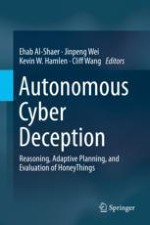2019 | OriginalPaper | Buchkapitel
2. Towards Intelligent Cyber Deception Systems
verfasst von : Fabio De Gaspari, Sushil Jajodia, Luigi V. Mancini, Giulio Pagnotta
Erschienen in: Autonomous Cyber Deception
Aktivieren Sie unsere intelligente Suche, um passende Fachinhalte oder Patente zu finden.
Wählen Sie Textabschnitte aus um mit Künstlicher Intelligenz passenden Patente zu finden. powered by
Markieren Sie Textabschnitte, um KI-gestützt weitere passende Inhalte zu finden. powered by
